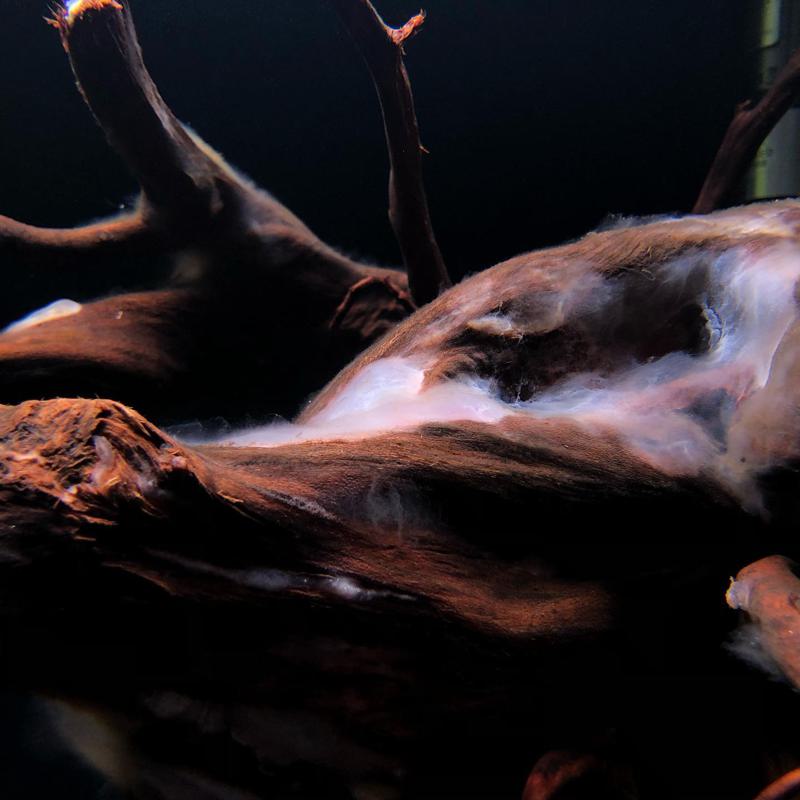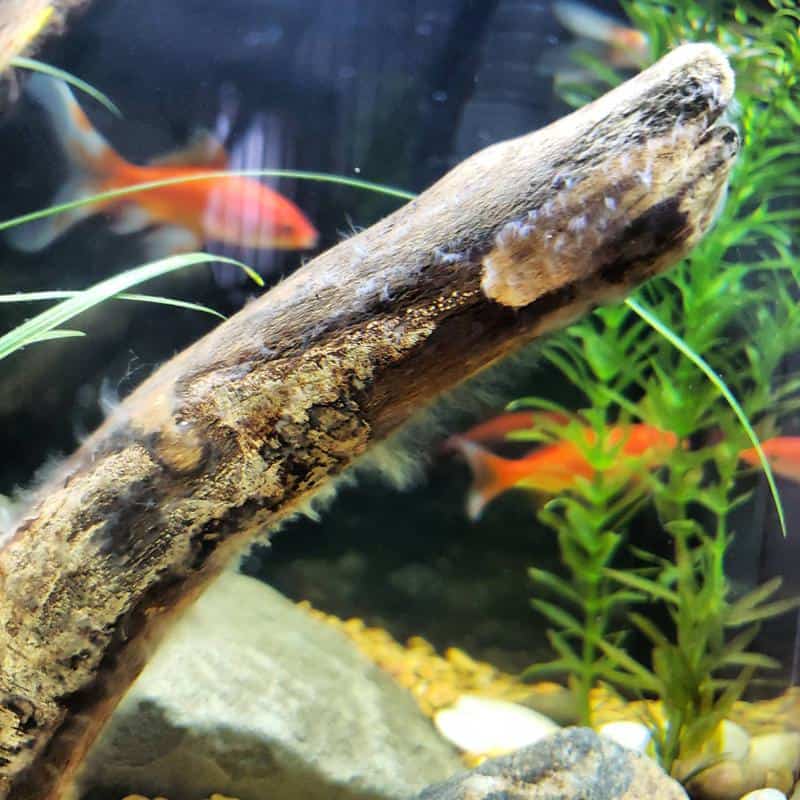Maybe you’ve noticed white fuzzy patches growing on aquarium plants, rocks, or driftwood. Well, chances are white algae are present in your fish tank.
White algae are annoying because they spread fast. A white algae aquarium typically features stringy things that hang from leaves or glass.
What are these weird creatures and are they dangerous?
While those common aquarium algae aren’t harmful to fish, they develop and multiply quickly. This makes it difficult to get rid of them.
Fortunately, there are different ways to remove white algae for good. Read on to learn how to prevent or get rid of these pesky algae, what they are, what causes them, and much more.
What Are White Algae?

Algae are a form of plant life that usually grows in water. They are responsible for producing over 50% of the oxygen in our atmosphere.
There are two main types of algae: green and brown. Green algae is the most common type found in nature and fish tanks, but brown algae can also grow there if conditions are right.
You have probably heard of them, but do you know that there are white algae too? Also known as white hair algae, these photosynthetic eukaryotic organisms make up the base of the marine food chain.
These unicellular organisms are typically found in freshwater and saltwater. This type of algae also grows in freshwater aquariums, so don’t be surprised if you see them in your fish tank.
What’s more, they’re common aquarium “visitors.” White algae can be found in many different types of aquatic environments and they are a very common sight in aquariums.
How do you recognize them? They form fuzzy or stringy patches on plants, grass, as well as aquarium items and decorations. A typical white alga has an extremely slick film.
Causes of White Algae: Why Do They Develop in Fish Tanks
Now that you know what white algae are and how to identify them, you should also know what causes them in fish tanks. This will help you prevent them from developing in your tank.
That’s why you need to familiarize yourself with factors contributing to the growth of these organisms. There are many reasons for their development and invasion, including:
- Excess nutrients
- Improper pH levels
- Overly bright conditions
- Overcrowding
- Poor water circulation
Too High Levels of Nutrients
Be sure to measure the levels of nutrients regularly and adjust them as needed. Otherwise, you may end up with excess nutrients and white algae in your fish tank.
Pay particular attention to the levels of phosphates and nitrates. White algae love these nutrients.
Use a high-quality filter to prevent excess nutrients. This way you will also keep white algae from developing and growing in your tank setup or aquarium.
Do not overfeed fish and control the settings regularly! Check the following table for the ideal fertilizer values.
| Type of fertilizer/nutrient | Ideal quantity (mg/l) |
| CO2 | 20-35 |
| Nitrate (NO3) | 10-30 |
| Phosphate (PO4) | 0.1-1.5 |
| Potassium (K) | 10-30 |
| Iron (Fe) | 0.1-0.5 |
| Magnesium (Mg) | 5-10 |
Improper pH Levels
Likewise, you should control pH levels on a regular basis. Why is this important?
This will ensure that your aquarium pets are in good health condition. Besides that, proper pH levels can prevent white hair algae from starting to grow in your tank.
If you have a freshwater tank or aquarium, make sure the pH level is always from 6.5 to 7.5. It is considered an ideal level. Anything beyond this range will support the growth of white algae.
Excess Light in Tanks
The lighting conditions also matter. If you rely on natural light and your aquarium gets too much light, it will promote the growth of algae.
That’s because they thrive in brightly lit fish tanks. Excess light is likely to be the cause of white algae if your tank receives direct sunlight or is positioned by the window.
As a general rule of thumb, fish tanks only need 9 hours of light per day. Apply this rule and avoid direct sunlight to prevent algae from building up.
Overcrowding
If there are a lot of fish and items in your aquarium, this will increase the risk of algae growth. So make sure it is not overcrowded.
Do not add plenty of decorative and unnecessary items, especially if your tank is small. Consider the size of your tank and the number of your pets to avoid overcrowding.
More fish, more waste. They produce waste in the water, meaning white algae have more nutrients to feed on.
Poor Water Flow
Bad water circulation is one of the most common reasons for the white algae problem. It gives rise to stagnant water pockets, which may result in algae invasion.
These areas usually form in new setups because it takes time for the water to regulate in aquariums. White algae love growing in water pockets, so they are the ideal breeding ground for them.
Improve water circulation to prevent this problem. Check out the filtration, too.
If your fish tank lacks filtration or it’s poor, you may experience the invasion of white algae. To make your tank function smoothly and properly, make sure it is equipped with all the tools needed.
You should also consider upgrading your aquarium filter from time to time. Aside from removing accumulated waste products, it can improve water flow.
Are White Algae Harmful?
Have you noticed them in your fish tank? Don’t worry – white algae aren’t dangerous.
Unlike brown algae, they don’t release toxins that are harmful to fish. Apart from fish, other tank occupants can also grow and live along with white algae without any problem.
They are quite unsightly and annoying, though. White hair algae make aquariums appear very grimy.
This is because they tend to grow quickly, covering the glass, plants, and driftwood. Hence, it represents a nuisance in fish tanks.
Keeping the aquarium clean is of great importance. That’s why you should prevent algae invasion.
Have white algae already appeared in your fish tank? Then you need to choose the most effective way to deal with them.
Continue scrolling to find out how to treat white algae and get rid of them.
How to Deal with White Algae Invasion
If you know the cause of algae bloom, you can find the right solution. Here are a few tips for dealing with white algae:
- Improve water circulation
- Adjust the pH levels properly
- Remove excess nutrients
- Avoid overfeeding
- Decrease the quantity of light
- Change the water regularly
Dealing with Algae on Plants
It is not uncommon for algae to grow on aquarium grass and other plants. How do you deal with this problem?
The key is to have a properly lit aquarium. Therefore, finding the right balance is imperative for fishkeeping.
Be sure to have well-maintained plants that are capable of competing with white algae for nutrients. You want them to be healthy in order to surpass algae when it comes to food resources.
This will decrease the likelihood of algae growth in your aquarium. On the other hand, your plants are more likely to thrive.
Dealing with Algae on Driftwood

Driftwood is a nice addition to fish tanks that provide fish with a hiding place and shelter. Keeping it clean can be challenging, though.
It’s one of those areas that are ideal for debris and algae growth. Luckily, this problem can easily be solved by removing the driftwood from your aquarium and scrubbing it gently. Use a soft brush to avoid damaging the wood.
You want your tank to be free of debris and clean without excess nutrients. In addition to changing the water regularly, it is a good idea to use vacuum cleaners.
Dealing with Algae on Glass
Make sure your tank is receiving enough light (but not too much) to prevent the growth of white algae. Also, carry out water changes frequently to avoid excess nutrients on the glass.
Keep the glass clean! It will let you enjoy a clear algae-free fish tank.
How to Get Rid of White Hair Algae?
As the saying goes, prevention is better than cure. This means you should try to prevent white algae from developing in your fish tank.
Are they already there? If so, you need to choose the best way to get rid of them to fix the problem as soon as possible.
Identifying the cause is the first thing to do. Once you have determined the cause of algae invasion, you will be able to pick the right method of treating it.
There are several ways to eliminate white algae from fish tanks, such as:
- Increasing the water flow
- Removing debris and excess nutrients
- Vacuuming the gravel
- Upgrading your tank filter
In addition to these methods, you may also consider adding algae eaters to your tank like shrimp and snails. We will talk more about them in the following section.
Related: How to Get Rid of Algae in the Fish Tank?
What Eats White Algae?
There are a variety of invertebrates and aquarium fish that consume white hair algae. This can be an effective “biological weapon.” Listed below are the 10 popular algae eaters:
- Nerite snails
- Otocinclus
- Barbs
- Malaysian trumpet snails
- Amano shrimp
- American flagship
- Siamese algae eaters
- Danios
- Sun snails
- Chinese algae eaters
Remember that each type of snail, fish, and shrimp prefers eating a specific kind of algae. Choose one that is most effective at controlling the population of white algae in particular.
It is also important to insert species that are compatible with your fish and other aquarium mates. Ideally, you want to add ones that have no specific care requirements.
Read More:
FAQs
Is White Algae on Driftwood Dangerous?
Nope. Whether they develop on driftwood or another aquarium item, white algae are not harmful to fish and plants. Grab a soft brush and scrub the wood gently to remove them.
Do I Have Fungi or White Algae?
Fungi and white algae look similar. That is why they are often confused for one another.
White algae look like white stringy or fuzzy patches growing on different surfaces. On the other hand, fungi (also known as water molds) are usually characterized as a cottony growth on aquarium plants and items.
Do Dead Algae Turn White in Fish Tanks?
Yes, they can turn white. However, dead alga may turn grey sometimes. This gradually drops, allowing you to safely remove it from your aquarium.
How Long Does It Take to Get Rid of White Algae?
Removing white algae can be a time-consuming process because their invasion is difficult to control. Do not be frustrated.
A prediction of the time required involves assessing the infection severity. It depends on various factors from aquarium maintenance to the type and size of the fish tank.
While most invasions can be beaten in a couple of weeks, sometimes it takes a few months to remove these pesky algae. It may take several tries.
Try to find out as much as possible about white hair algae to get rid of them faster. Be patient!